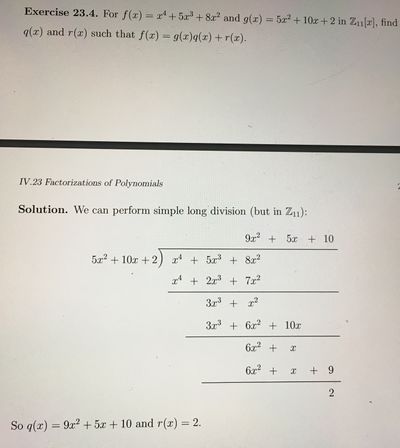Math 361, Spring 2017, Assignment 4
From cartan.math.umb.edu
Carefully define the following terms, then give one example and one non-example of each:[edit]
- Divisibility relation (in an integral domain).
- Associate relation (in an integral domain).
- Irreducible element (of an integral domain).
- Unique factorization domain.
Carefully state the following theorems (you do not need to prove them):[edit]
- Universal mapping property of $R[x]$ (this is not stated concisely in the book; it is the statement concerning "generalized evaluation homomorphisms" that we gave in class).
- Theorem concerning polynomial long division.
- Fundamental theorem of arithmetic.
- Theorem concerning unique factorization of polynomials.
- Factor theorem.
- Bound on the number of roots of a polynomial.
Solve the following problems:[edit]
- Section 23, problems 1, 3, 9, 11, 13, and 27.
- Working in $\mathbb{Z}_5[x]$, find all associates of the polynomial $x^2+3$.
Questions[edit]
I am don't Understand how the follow picture below works I believe in understanding the picture I can Understand question 3 on section 23 pg. 218 which asks about $f(x)=x^5-2x^4+3x-5$ and $g(x)=2x+1$ in $\mathbb{Z}_{11}$
- In $\mathbb{Z}_{11}$, we have $5\times 9 = 45 = 1$. Therefore, $5$ and $9$ are multiplicative inverses, and dividing by $5$ is the same as multiplying by $9$. Apart from this, the division is done exactly as one does it in high school (leading term over leading term, multiply, subtract, repeat). (In the picture, the quotient is not aligned in the same way that I'm accustomed to doing it; I would have put the $9x^2$ directly over the $x^4$ instead of over the $8x^2$.) -Steven.Jackson (talk) 13:06, 18 February 2017 (EST)
